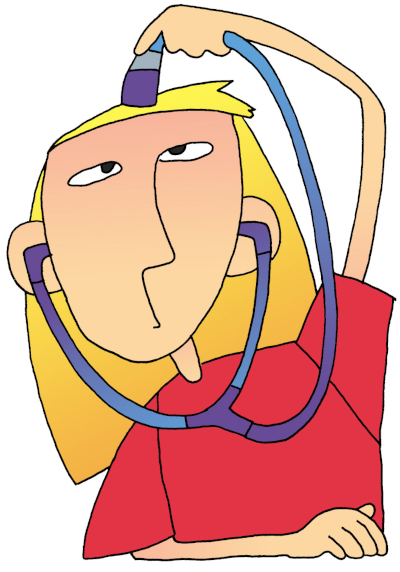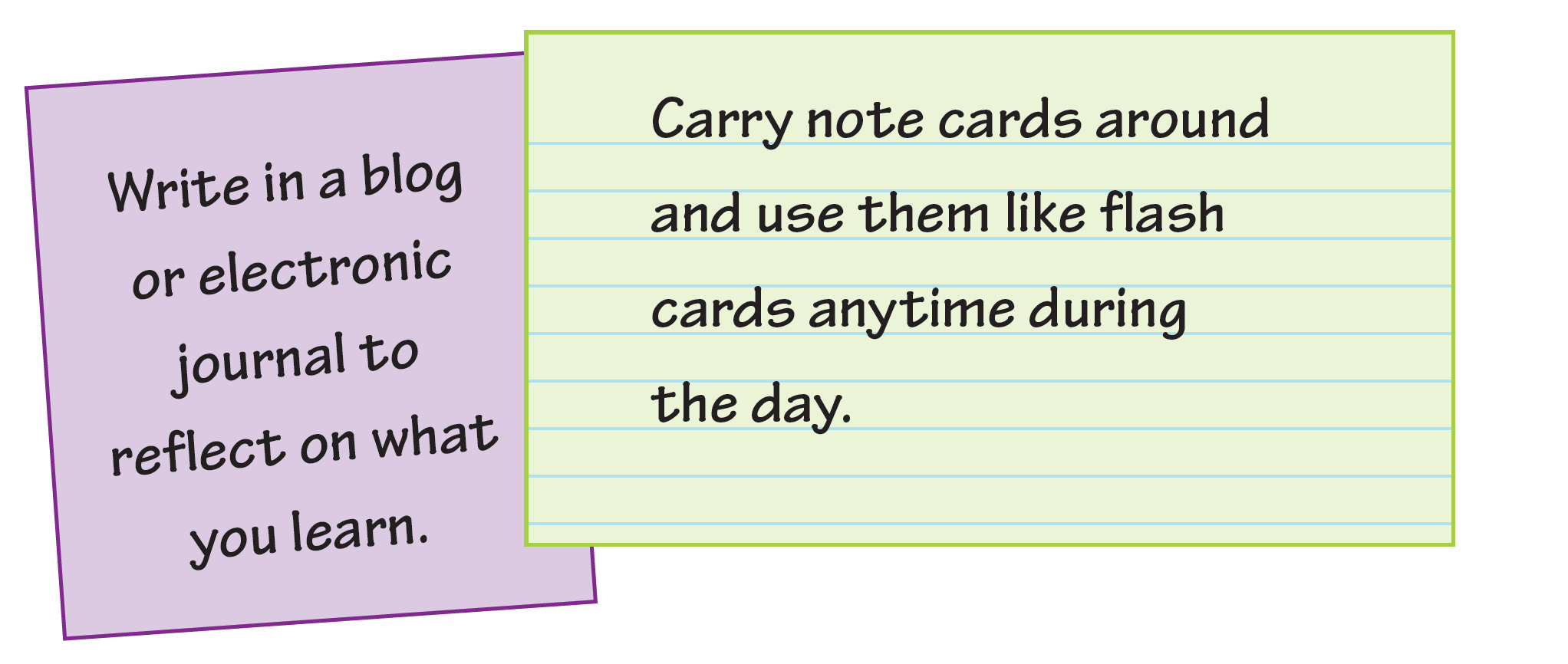Page 419

Taking Tests
We’ve all had the test nightmare: You walk into class only to discover that the final exam is today. What’s worse, you have forgotten to come to class every day before that! Everyone else is busy working on the test, and you’re still saying, “What class is this?”
A test dream is just the opposite: You walk into class for a test that you have carefully prepared for. You’ve paid attention in class and feel confident that you will do well.
So, that’s the best way to succeed on tests: Keep up in class. You’ll also find other tips here for doing your best with different question types, like multiple choice, fill in the blank, and writing prompts.
What’s Ahead
WE 420
Page 420
Preparing for the Test
Ask questions.
- What will be on the test? (Ask your teacher.)
- What kind of test will it be? (Multiple choice? Essay?)
Review your notes.
- Reread your class notes carefully. (Get any notes or materials you may have missed.)
- Rewrite your most important notes or put them on note cards.
Review your textbook.
- Skim your textbook. (Also review quizzes and worksheets.)
- Read difficult material out loud as you review.
Taking the Test
Listen attentively.
- Listen carefully to your teacher. How much time will you have? Can you use notes, a dictionary, or your handbook?
Read carefully.
- Take a quick look at the whole test, so you know which questions will take the most time.
- Then go back and read the directions carefully. Be on the lookout for words like always, only, all, and never.
- Don’t spend too much time on any one question.
Check closely.
- Double-check to be sure you have answered all the questions. (Check each answer if you have time.)
- Ask your teacher about any questions that still confuse you.
WE 421
Page 421
Responding to Writing Prompts
Sometimes test questions are prompts that ask you to share what you know about a certain topic by writing about it. Here are two samples:
In a paragraph, explain what happens in a tsunami.
In a paragraph, describe a tsunami.
Each prompt asks you to write about the topic in a different way. The first asks you to explain a tsunami, and the second asks you to describe a tsunami.
1. Find the key word.
It is important to understand the key words used in test questions. Here are some common ones.
Compare/contrast 🟪 To compare, tell how two things are alike. To contrast, tell how things are different. A prompt may ask you to compare, contrast, or both. (Compare and contrast the Arctic and the Antarctic.)
Define 🟪 To define something, tell what it means, what it is, or what it does. (Define ultraviolet light.)
Describe 🟪 To describe something, tell how it looks, sounds, smells, tastes, and/or feels. (Describe the book’s main character.)
Explain 🟪 To explain something, tell how it works, how it happens, or how to do it. (Explain the effects of warming temperatures.)
List 🟪 To list, give a number of facts, ideas, reasons, or other details about the topic. (List five reasons the American Revolution began when it did.)
Persuade 🟪 To persuade, give facts and reasons that would convince someone to agree with your opinion or position. (Write a letter that persuades your classmates to help you clean the school grounds.)
WE 422
Page 422
2. Make good use of your time.
Here’s how to make the best use of your time:
- Carefully read or listen to all directions.
- Find out how much time you have for the test.
- Think about the prompt before you begin writing.
- Find the key word and think carefully about it.
- Make a simple plan or list for your writing.
- Once you begin, keep writing! (See pages 42 and 117.)
3. Focus on the key word.
The two answers below are completely different, even though they cover the same topic. The first answer explains; the second one describes.
Explain what happens in a tsunami. 🟪 The answer tells how a tsunami happens.
Oceanic plates move constantly, but sometimes they get locked up. Pressure builds between them. Suddenly, one plate surges upward, lifting all the ocean water above it. The water forms a huge wave that rolls in either direction. As the wave approaches shore, it rises up to 20 or 30 feet or more. It washes inland as if the ocean were suddenly deeper.
Describe a tsunami. 🟪 The answer tells how a tsunami looks, sounds, and smells.
As tsunami sirens scream in the air and beach-goers flee to higher ground, the ocean draws back. It exposes fish-smelling seabed. Then, in the distance, a white, foaming wall forms on the horizon. It sweeps in with a roar. The wall rushes onshore, tossing yachts down streets and making cars into boats and making buildings collapse or float away.
WE 423
Page 423
The Objective Test
To do well on an objective test, keep the following hints in mind.
Multiple-Choice Test
Read all the choices carefully. Don’t just mark the first correct choice, because there may be more than one correct answer. If there is, look for a choice such as “all of the above” or “both a and b.”
Question: Mammals are animals that
a. produce milk
b. grow hair
c. fly
d. both a and b
(Answer: d)
A question may ask you to find a mistake in one of the choices. Look to see if one of the choices is “no mistake.”
Question: Mark the sentence that needs to be corrected.
a. Cows and dogs are mammals.
b. Mammals are warm blooded.
c. People are mammals.
d. No mistake
(Answer: d)
Look for negative words like not, never, except, and unless. Also watch for numbers.
Question: The following two animals are not mammals.
a. shark
b. kangaroo
c. horse
d. spider
(Answers: a and d)
A question may ask you to mark the choice that matches a sample sentence. Read all the choices carefully.
Question: Mark the sentence in which control has the same meaning as in the following sentence:
Some mammals keep the insect population under control.
a. She tried to control her temper.
b. The pilot adjusted the right control.
c. The Salk vaccine helps keep polio under control.
(Answer: c)
WE 424
Page 424
True/False Test
On a true/false test, read the entire question before answering. For a statement to be true, the entire statement must be true. Watch for words like all, every, always, never. Statements with these words in them are often false.
Question: Mark each statement below with “True” or “False.”
1. Plastic can never be recycled.
2. All plastic can be recycled.
3. Vinyl is a kind of plastic used to make tires.
Answers: All are false.
1. Some plastic can be recycled.
2. Not all plastic can be recycled.
3. The first half is true—vinyl is a kind of plastic—but it is not used to make tires.
Matching Test
Before you make any matches, read both lists quickly. Check off each answer you use.
Question: Match the product to the recycled material that it is made from.
_______ Asphalt
_______ Mulch for plants
_______ Motor oil
a. Motor oil
b. Christmas trees
c. Tires
Answers:
(c) Asphalt
(b) Mulch for plants
(a) Motor oil
Fill in the Blanks
Read each sentence completely before filling in the blank.
Question: Fill in the blanks below with the correct answers.
1. Paper makes up about __________________ of our trash.
2. ______________ and ______________ can be recycled.
Answers: 1. one-third 2. Plastic, glass (etc.)
WE 425
Page 425
Remembering for Tests
In addition to knowing how to take a test, you have to remember the material you’re being tested on. Here are some tips for remembering what you have learned.
Use graphic organizers. 🟪 They help you organize information, and that makes the information easier to remember. (See pages 383–386.)
Use acronyms. 🟪 Acronyms are made up of the first letters of the words in a phrase or group of words. NATO, for example, is an acronym for North Atlantic Treaty Organization. To help you remember things, you can create your own acronyms.
HOMES
Huron, Ontario, Michigan, Erie, Superior (the Great Lakes)
ROY G. BIV
Red, Orange, Yellow, Green, Blue, Indigo, Violet (the colors of the rainbow)
Use poems. 🟪 Sometimes a simple (even silly) poem can help you remember things. Do you know this one?
Thirty days has September, April, June, and November.
All the rest have thirty-one, save February at twenty-eight.
But leap year, coming once in four—February then has one day more.
Use songs. 🟪 Sometimes a familiar song can help you remember things. You can substitute something you want to remember for the words in the song.

Talk to others. 🟪 Here are some ways that talking to others will help you learn and remember information:
- Form a study group. Ask each other questions.
- Teach someone else what may be on the test.
- Recite out loud the key points you need to remember.
WE 426
Page 426
Draw or visualize. 🟪 Drawing or picturing something in your mind can help you remember. Here’s an example of a drawing used for remembering prepositions.

Rewrite it. 🟪 There are many ways to use writing to help you learn and remember. You can begin by writing in a journal or learning log. (See pages 115–120 and 121–124 for more suggestions.)
